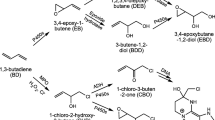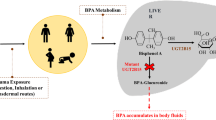Abstract
Chronic exposure to benzene leads to blood dyscrasias characterized by progressive depression in the levels of circulating leukocytes, thrombocytes, and/or erythrocytes, eventually leading to pancytopenia and aplastic anemia (1). The literature contains many descriptions of human benzene toxicity following chronic inhalation (2–4) and the process has been reproduced in several animal species either by exposing animals to atmospheric benzene (5,6) or by parenteral administration of benzene (7,8). The mechanism by which benzene produces bone marrow depression has been explored in a series of studies by Kissling and Speck (9,10) and by Boje et al. (11), who demonstrated that nucleic acid synthesis in bone marrow was inhibited in chronic benzene toxicity, but the molecular site of action is as yet unknown.
Access this chapter
Tax calculation will be finalised at checkout
Purchases are for personal use only
Preview
Unable to display preview. Download preview PDF.
Similar content being viewed by others
References
R. Snyder and J. J. Kocsis, Current concepts of chronic benzene toxicity, Crit. Rev. Toxicol. 3, 265–288 (1975).
E. Browning, Toxicity and Metabolism of Industrial Solvents, Chap. 1, Elsevier, Amsterdam (1965).
G. Saita, Benzene induced hypoplastic anemias and leukemias, in: Blood Disorders Due to Drugs and Other Agents (R. H. Girdwood, ed.), pp. 127–146, Excerpta Medica, Amsterdam (1973).
M. Aksoy, K. Dincol, S. Erdem, T. Akgun, and G. Dincol, Details of blood changes in 32 patients with pancytopenia associated with long term exposure to benzene, Br. J. Ind. Med. 29, 56–64 (1972).
H. G. Weiskotten, C. B. F. Gibbs, E. O. Boggs, and E. R. Templeton, The action of benzol. VI. Benzol vapor leucopenia (rabbit), J. Med Res. 41, 425–438 (1920).
W. B. Deichmann, W. E. MacDonald, and E. Bernal, Hemopoietic tissue toxicity of benzene vapors, Toxicol. Appl. Pharmacol. 5, 201–224 (1963).
L. Selling, Benzol as a leucotoxin: Studies on the degeneration and regeneration of the blood and haematopoietic organs, Johns Hopkins Hosp. Rep. 17, 83–148 (1916).
J. S. Latta and L. T. Davies, Effects on the blood and hemopoietic organs of the albino rat of repeated administration of benzene, Arch. Pathol. 31, 55–67 (1941).
M. Kissling and B. Speck, Chromosome aberrations in experimental benzene intoxication, Helv. Med. Acta 36, 59–66 (1969).
M. Kissling and B. Speck, Further studies on experimental benzene induced aplastic anemia, Blut 25, 97–103 (1972).
V. H. Node, W. Benkel, and H. J. Hemiger, Untersuchungen zur Leukopoese in Knochenmark der Ratte nach chronischer Benzol Inhalation, Blut 21, 250–257 (1970).
J. W. Porteous and R. T. Williams, Studies in detoxication. 19. The metabolism of benzene I. (a) The determination of phenol in urine with 2:6-dichloroquinonechioroimide. (b) The excretion of phenol glucuronic acid and ethereal sulfate by rabbits receiving benzene and phenol. (c) Observations on the determination of catechol, quinol and muconic acid in urine, Biochem. J. 44, 46–55 (1949).
J. W. Porteous and R. T. Williams, Studies in detoxication. 20. The metabolism of benzene. II. The isolation of phenol, catechol, quinol and hydroxyquinol from the ethereal sulfate fraction of the urine of rabbits receiving benzene orally, Biochem. J. 44, 56–61 (1949).
D. V. Parke and R. T. Williams, Studies in detoxication. 49. The metabolism of benzene containing 14C, benzene, Biochem. J. 54, 231–238 (1953).
D. V. Parke and R. T. Williams, Studies in detoxication. 54. The metabolism of benzene. (a) The formation of phenyl glucuronide and phenylsulfuric acid from 14C benzene. (b) The metabolism of i4C phenol, Biochem. J. 55, 337–340 (1953).
L. M. Gonasun, C. M. Witmer, J. J. Kocsis, and R. Snyder, Benzene metabolism in mouse liver microsomes, Toxicol. Appl. Pharmacol. 26, 398–406 (1973).
R. Snyder, F. Uzuki, L. Gonasun, E. Bromfeld, and A. Wells, The metabolism of benzene in vitro, Toxicol. Appl. Pharmacol. 11, 346–360 (1967).
J. J. Kocsis, S. Harkaway, M. C. Santoyo, and R. Snyder, Dimethyl sulfoxide: Interactions with aromatic hydrocarbons, Science 160, 427–428 (1968).
R. T. Drew, J. R. Fouts, and C. Harper, The influence of certain drugs on the metabolism and toxicity of benzene, in: Symposium on Toxicology of Benzene and Alkylbenzenes, (D. Braun, ed.), pp. 17–31, Industrial Health Foundation, Pittsburgh (1974).
R. T. Drew and J. R. Fouts, The lack of effects of pretreatment with phenobarbital and chlorpromazine on the acute toxicity of benzene in rats, Toxicol. Appl. Pharmacol. 27, 183–193 (1974).
P. Dustin, Jr., The action of mitotic poisons on normal and pathological blood cell formation, Sang 21, 297–330 (1950).
T. Hirokawa and K. Nomiyama, Studies on poisoning by benzene and its homologues. (5) Oxidation rate of benzene in rat liver homogenates, Med. J. Shinshu Univ. 7, 29–39 (1962).
K. Nomiyama, Studies on poisoning by benzene and its homologues. (6) Oxidation rate of benzene and benzene poisoning, Med. J. Shinshu Univ. 7, 41–48 (1962).
K. Nomiyama, Experimental studies on benzene poisoning, Bull. Tokyo Med. Dent. Univ. 11, 297–313 (1964).
K. Nomiyama, Studies on poisoning by benzene and its homologues. (7) Toxicity of benzene metabolites to hemopoiesis, Ind. Health 3, 53–57 (1965).
M. Ikeda, Enzymatic studies on benzene intoxication, J. Biochem. (Tokyo) 55, 231–243 (1964).
M. Ikeda and H. Ohtsuji, Phenobarbital-induced protection against toxicity of toluene and benzene in the rat, Toxicol. Appl. Pharmacol. 20, 30–43 (1971).
M. Ikeda, H. Ohtsjui, and T. Imamura, In vivosuppression of benzene and styrene oxidation by co-administered toluene in rats and effects of phenobarbital, Xenobiotica 2, 101–106 (1972).
A. M. Tschernikow and I. D. Gadaskina, Oxidation of benzene in the liver of warm and cold-blooded animals, Naunyn-Schmiedebergs Arch. Pharmakol. 154, 222–227 (1930).
C. Harper, R. T. Drew, and J. R. Fouts, Species differences in benzene hydroxylation to phenol by pulmonary and hepatic microsomes, Drug Metab. Dispos. 3, 381–388 (1975).
I. D. Gadaskina, Z. I. Abramova, and Z. I. Bikerskaya, Participation of bone marrow in the oxidation of benzene, Gig. Tr. Prof. Zabol. 12, 2–7 (1963).
A. J. Erslev, Pathophysiology of aplastic anemia, in: Drugs and Hematologic Reactions(N. V. Dimitrov and J. H. Nodine, eds.), pp. 65–78, Grune and Stratton, New York (1974).
D. Jerina and J. W. Day, Arene oxides: A new aspect of drug metabolism, Science 185, 573–582 (1974).
F. Marks and E. Hecker, Metabolism and mechanism of action of oestrogens. XII. Structure and mechanism of formation of water soluble and protein-bound metabolites of oestrone in rat liver microsomes in vitroand in vivo, Biochim. Biophys. Acta 187, 250–265 (1969).
H. Kappus, H. M. Bolt, and H. Remmer, Irreversible protein binding of metabolites of ethynylestradiol in vivoand in vitro, Steroids 22, 203–225 (1973).
E. Dybing, J. R. Mitchell, S. D. Nelson, and J. R. Gillette, Metabolic activation of methyldopa by cytochrome P450-generated superoxide anion, Chap. 17, this volume.
W. B. Dietering, Uber Brenzcatechin-vergiftung, Naunyn-Schmiedebergs Arch. Pharmakol. 188, 493–499 (1938).
Author information
Authors and Affiliations
Editor information
Editors and Affiliations
Rights and permissions
Copyright information
© 1977 Plenum Press, New York
About this chapter
Cite this chapter
Snyder, R., Andrews, L.S., Lee, E.W., Witmer, C.M., Reilly, M., Kocsis, J.J. (1977). Benzene Metabolism and Toxicity. In: Jollow, D.J., et al. Biological Reactive Intermediates. Springer, Boston, MA. https://doi.org/10.1007/978-1-4613-4124-6_31
Download citation
DOI: https://doi.org/10.1007/978-1-4613-4124-6_31
Publisher Name: Springer, Boston, MA
Print ISBN: 978-1-4613-4126-0
Online ISBN: 978-1-4613-4124-6
eBook Packages: Springer Book Archive




